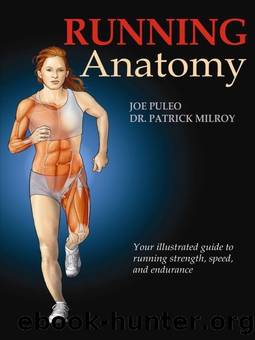Running Anatomy by Joseph Puleo & Patrick Milroy

Author:Joseph Puleo & Patrick Milroy [Puleo, Joseph]
Language: eng
Format: mobi
Publisher: Human Kinetics
Published: 2009-12-14T16:00:00+00:00
Figure 7.2 Lower core through upper leg: (a) back; (b) front.
Muscles may be distinct entities, but often merge into one another and when dissected can be difficult to separate. The running action is repetitive, so that muscles with even slightly different functions may oppose each other during the running cycle and actually produce negative frictional forces. Where this may happen, a small fluid-filled sac called a bursa may form, the largest of which is over the greater trochanter, known as a trochanteric bursa. This may become inflamed and sore.
Returning to the pelvis and its adjacent organs, the abdomen, unlike the chest, does not have a bony architecture to stabilize it. The vertical height is maintained by the lumbar vertebrae. The responsibility for stability falls to the abdominal contents, which exert a counterpressure to a surrounding circular wall of muscles formed by the rectus abdominis, which extends from the base of the rib cage centrally down to the pubic symphysis and bone (figure 7.3). Outside this and lying diagonally are the external and internal oblique and the transversus abdominis muscles, which have three functions: to abduct and rotate the trunk, to flex the lumbar and lower thoracic vertebrae forward, and to contain the abdomen. When running, these muscles alternately lengthen and shorten as the pelvis moves not only from side to side, but also twists, rises, and falls relative to the surrounding body parts. In addition, they have a function to aid respiration at high rates, working in conjunction with the diaphragm and ribs, which is particularly noticeable if the runner is reduced to panting. Thus, they have multiple roles, all of which may be required at the same time, and will perform better if well and thoroughly trained.
Download
This site does not store any files on its server. We only index and link to content provided by other sites. Please contact the content providers to delete copyright contents if any and email us, we'll remove relevant links or contents immediately.
Tools of Titans by Timothy Ferriss(7813)
Bodyweight Strength Training by Jay Cardiello(7674)
Born to Run: by Christopher McDougall(6894)
Inner Engineering: A Yogi's Guide to Joy by Sadhguru(6441)
Asking the Right Questions: A Guide to Critical Thinking by M. Neil Browne & Stuart M. Keeley(5356)
The Fat Loss Plan by Joe Wicks(4620)
Bodyweight Strength Training Anatomy by Bret Contreras(4467)
Yoga Anatomy by Kaminoff Leslie(4100)
Science and Development of Muscle Hypertrophy by Brad Schoenfeld(3971)
Dynamic Alignment Through Imagery by Eric Franklin(3919)
ACSM's Complete Guide to Fitness & Health by ACSM(3824)
The Four-Pack Revolution by Chael Sonnen & Ryan Parsons(3793)
Exercise Technique Manual for Resistance Training by National Strength & Conditioning Association(3786)
Bodyweight Strength Training: 12 Weeks to Build Muscle and Burn Fat by Jay Cardiello(3779)
Yoga Anatomy by Leslie Kaminoff & Amy Matthews(3739)
The Ultimate Bodybuilding Cookbook by Kendall Lou Schmidt(3707)
Yoga Therapy by Mark Stephens(3573)
Nutrition for Sport, Exercise, and Health by Spano Marie & Kruskall Laura & Thomas D. Travis(3556)
Nutrition for Sport, Exercise, and Health by Marie Spano & Laura Kruskall & D. Travis Thomas(3548)
